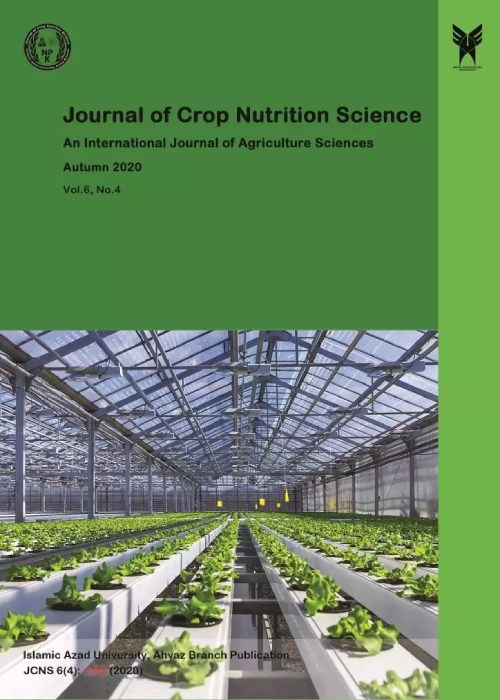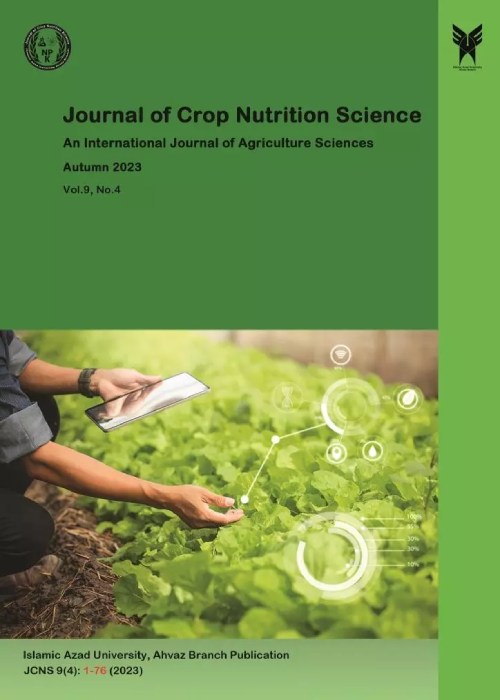فهرست مطالب

Journal of Crop Nutrition Science
Volume:6 Issue: 4, Autumn 2020
- تاریخ انتشار: 1399/10/11
- تعداد عناوین: 6
-
Pages 1-13BACKGROUNDGibberellins (GAs) are essential endogenous hormones found in plants and fungi controlling plant development by regulating several physiological mechanisms.OBJECTIVESThis research was done to assess the effect of different amount and time of apply Gibberellin acid on quantitative and qualitative characteristics of Broad bean.METHODSThis research was conducted according factorial experiment based on randomized complete blocks design with three replications along 2010 year. The treatments included different concentration of Gibberellin (nonuse of Gibberellin or control, 5 ppm, 50 ppm and 250 ppm) and time of application Gibberellin (Vegetative growth before flowering, flowering until pod emergence, Pod emergence until grain filing).RESULTResult of analysis of variance revealed effects of different amount, time of apply Gibberellin acid and interaction effect of treatments on all studied traits was significant. Assess mean comparison result of interaction effect of treatments indicated maximum amount of number of pod per plant (17.34), number of seed per pod (7.48), seed weight (1320 gr), seed yield (2899 kg.ha-1), harvest index (48.50%), biologic yield (6140 kg.ha-1), leaf area index (2.61), protein content (30.00%) and nitrogen content (4.80%) was noted for 50 ppm and vegetative growth before flowering and lowest amount of mentioned traits belonged to nonuse of Gibberellin acid at pod emergence until grain filing.CONCLUSIONUse 50 ppm Gibberellin acid at vegetative growth before flowering led to produce maximum amount of quantitative and qualitative studied traits and can proposed to farmers in studied region.Keywords: Dry weight, leaf area index, nitrogen, Protein, Pulse
-
Pages 14-25BACKGROUNDFertilizer management plays an important role for obtaining satisfactory yields and increase crop productivity. Nutrient management may be achieved by the involvement of organic sources, bio fertilizers, and micro-nutrients.OBJECTIVESCurrent study was done to determine the effect of different level of nitrogen and wheat genotypes on agronomic traits, seed growth rate and correlation between characteristics.METHODSStatistical pattern was split plot experiment according randomized complete block design with three replications. Main factor included four levels of nitrogen fertilizer (N1=60, N2=120, N3=180, N4=240 kg.ha-1, Urea Source) and sub plots consisted four genotypes of Bread (V1: S85-19 as line, V2: Chamran) and Durum (V3: Behrang, V4: Dena) Wheat.RESULTResult of analysis of variance indicated effect of nitrogen fertilizer (instead number of seed per spikelet and 1000-seed weight), genotypes (instead number of seed per spikelet) and interaction effect of treatments (instead number of spikelet per spike, number of seed per spikelet, 1000-seed weight and harvest index) on all measured traits was significant. Correlation between traits showed the significant correlation between biologic yield (r=0.97**), seed weight (r=0.92**), harvest index (r=0.91**), number of seed per m2 (r= 0.77**), number of seed per spike (r= 0.75**), number of seed per spikelet (r= 0.71**), rate of current photosynthesis (r= 0.69**), rate of redistribution (r= 0.66**), number of spike per m2 (r= 0.62*), number of spikelet per spike (r= 0.59*), contribution of current photosynthesis (r= 0.59*), efficiency of current photosynthesis (r= 0.54*) and seed yield was observed.CONCLUSIONThe highest grain filling rate belonged to use 240 and 180 kg.ha-1 nitrogen fertilizer and Chamran genotype at 27 days after anthesis.Keywords: Bread, Durum, Contribution of current photosynthesis, Efficiency of redistribution, Number of spikelet, Seed weight
-
Pages 26-34BACKGROUNDIron (Fe) is one of the essential elements for the plant and plays an important role in the many plant processes such as photosynthesis, respiration, nitrogen uptake and construction, and also in construction and development of chloroplasts in plants. Bio-fertilizers are more environmental friendly and in many cases, they have given the same or even better crop yields compared to mineral fertilizers.OBJECTIVESThis study was carried out to determine effect of different level of vermicompost and Nano iron fertilizer on quantitative and qualitative traits of corn.METHODSThis research was conducted according split plot experiment based on randomized complete blocks design with three replications along 2018 year in research farm of Islamic Azad University of Ahvaz Branch. Main plot included three level of vermicompost (V0: nonuse of vermicompost or control, V1: 5 t.ha-1 vermicompost, V2: 10 t.ha-1 vermicompost) was consumed at planting stage. Also subplots consisted four level of Nano iron fertilizer (F0: Nonuse of Nano iron fertilizer or control, F1: 0.002 L.ha-1, F2: 0.004 L.ha-1 and F3: 0.006 L.ha-1 Nano iron fertilizer) was used at 3 to 4 leaves stage.RESULTBased on result of analysis of variance effect of different level of vermicompost, Nano iron fertilizer and interaction effect of treatments on all studied traits was significant. Evaluation mean comparison result of interaction effect of treatments indicated the maximum amount of seed yield (545.7 gr.m-2), protein content (15.75%), protein yield (120.8 gr.m-2), Oil content (9.44%) and Oil yield (51.69 gr.m-2) were for 10 t.ha-1 vermicompost with 0.006 L.ha-1 iron Nano fertilizer, also lowest amount of measured traits was for nonuse of vermicompost and iron Nano fertilizer (control) treatments.CONCLUSIONGenerally according result of current research the maximum amount of seed yield, protein and oil content and protein and oil yield belonged to use 10 t.ha-1 vermicompost with 0.006 L.ha-1 iron Nano fertilizer.Keywords: Fertilizer, Nutrition, qualitative traits, Seed, Yield
-
Pages 35-41BACKGROUNDTerminal heat stress affected on qualitative characters. Identification of relation between heat tolerance and baking quality is more important. Many quality characteristics are important for the utilization of wheat, particularly flour protein concentration and bread-making properties.OBJECTIVESThis study was performed to evaluate the tolerance of bread wheat genotypes qualitative traits to extreme heat stress (above 40 C◦). Genotypes were evaluated in two separate experiments in 2 years.METHODSThe experiment was laid out in split- split- plot design with 3 replications at field of Safi Abad Dezful (Khuzestan province of Iran) Agricultural Research Station in 2014-2016. To study qualitative traits and seed protein, 4 genotypes (Chamran, Baj, Chamran2 and ER-92-19), 3 cultivation methods (stripe, 2 line on bed and 3 line on bed) and 3 seed rate (400, 600 and 800 seed.m-2) are selected.RESULTSeven qualitative traits involve bread value (BV), hardening index (HI), Moisture%, Protein%, WA% (water absorbance), Zeleny and Wet gluten was measured. Correlation coefficient results seed protein% had negative with HI, BV and Zeleny. BV had positive correlation with HI and positive with flour moisture and wet gluten. Results showed that cultivation method influence on BV and seed protein. Only BV influenced by seed rate. In 600 seed.m-2 BV was the least (513.21) and in 800 seed.m-2 was the most (519.28). Genotypes in BV, HI, protein and Zeleny had significant differences. These results are so useful for preparing gluten free breads. But more research require.CONCLUSIONIn hot climate such as north of Khuzestan province of Iran that spring has above temperature and multiple cropping system is usual, cultivation of tolerant and early mature genotypes had economical. In Addition with good management, seed quality is better than forecasting. So researchers can promote this project and farmers can use these results surely.Keywords: Bread value, Hardening index, Protein, Seed, Zeleny
-
Pages 42-55BACKGROUNDThe macro and micronutrients play an important role in the crop nutrition and thus they are important for achieving higher yields, better growth and development of plants.OBJECTIVESThis study aimed to investigate the effect of supplemental nutrition (chemical and organic fertilizer) on quality parameters and grain yield of wheat cultivars under irrigation condition with drain water of farms.METHODSThis experiment was carried out as a split-split plot in a randomized complete block design with three replications. The treatments included irrigation at two levels of drain water and pure water irrigation in the main plot, fertilizer compounds at six levels, growth promotion and high potassium in sub-plot and sub-sub plot including wheat cultivars (Mehregan, Shoosh, and Chamran2).RESULTThe results indicated that the traits of grain yield, harvest index, number of tillers, number of spikelet per spike, number of grain per spike were affected by fertilizer treatment and grain yield, biological yield, and harvest index were affected by irrigation. The number of grains per spike in irrigation with pure water had a higher average. The highest thousand grain weight and the number of tillers were obtained in Chamran2 cultivar. The highest grain protein content was achieved in Mehregan cultivar. The results of correlation analysis revealed that the number of tillers had a significant direct correlation with the variables of number of spikelet per spike, number of grains per spike, and grain yield. In examining the interaction of treatments, the highest grain yield was obtained in the application of humic acid seed inoculation and growth promotion of Shoosh wheat cultivar under drain water irrigation.CONCLUSIONthe highest amounts of grain yield were obtained approximately 6925 kg per hectare by applying humic and growth-promoting fertilizers in irrigation conditions with drain water of fields in Shoosh wheat cultivar.Keywords: Correlation, Growth promotion, Humic acid, Proline, Seed weight
-
Pages 56-63
Bio-fertilizers play a very significant role in improving soil fertility by fixing atmospheric nitrogen, both, in association with plant roots and without it, insoluble soil phosphates and produces plant growth substances in the soil. They are in fact being promoted to harvest the naturally available, biological system of nutrient mobilization. Chemical fertilizers are significant to succor nutrients in soil. Heavy doses of chemical fertilizers and pesticides are commonly used in order to enhance corn yields. Excessive nitrogen content in soil causes an inappropriate high uptake of this macronutrient by plants, which may result in inadequate growth and development due to the accumulation of nitrogen compounds in plant tissue. Growth prompting bacteria are including Azotobacter, Azospirillum and Pseudomonas. Azobacter, a free living and heterotrophic bacteria fixes nearly 20 to 40 kg nitrogen ha-1 and increases yield up to 50% 30. Combination fertilizer and biofertilizer also increases the rate of water and nutrient absorbance which raise the rate of growth and photosynthesis. These combination also increase the grain yield, yield components, and biological function, it has been found that bio-fertilizers can be combined with chemical fertilizers in a complementary way to reduce the excessive amount of chemical fertilizers used to grow corn. Applications of Nitroxin bio-fertilizer and chemical fertilizer (400 kg.ha-1 urea with 300 kg.ha-1 ammonium phosphate) had a significant effect on corn crop production. It seems according valid researchers consumption 150 kg Nitrogen ha-1 with 1 L.ha-1 Nitroxin led to achieve maximum corn seed yield and it can be advice to producers. Also use 50% Urea fertilizer plus Nitrokara biological fertilizer and 50% Triple Super phosphate fertilizer plus potabavar-2 could be considered by researchers and farmers.
Keywords: Agrophysiology, Azospirillum, Azotobacter, Fertility, Nutrition, Yield


